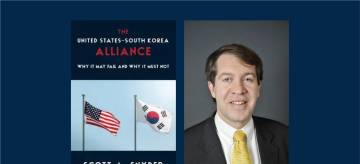Search 150 results
- Remove filter: Conflict & Warfare
- Remove filter: Economics
Filter by
Events
Series

The U.S.-South Korea alliance has been the cornerstone of bilateral cooperation and the U.S. security presence in the Indo-Pacific region for over seven decades and continues to serve as a model of partnership amid a growing range of challenges. Nevertheless, the rise of exclusive nationalism guided by “America First” or “Korea first” leadership that places national self-interest above alliance-based cooperation on shared challenges represents a point of vulnerability for the relationship. Combined with deepening political polarization in both countries, the cohesion and resilience of the U.S.-South Korea alliance may come under threat.
The United States–South Korea Alliance: Why It May Fail and Why It Must Not analyzes the internal and external threats to the alliance. It explores how a weakened U.S.-South Korea alliance could impact the security strategies of both countries and the broader security landscape in Northeast Asia. Additionally, it hypothesizes a future without the U.S.-South Korea alliance, shedding light on its potential impact and implications for U.S. and South Korean security strategies. Based on the analysis, the author concludes by offering valuable recommendations to the United States and South Korea for preserving and sustaining the alliance.
This book is suitable for the following disciplines in undergraduate and graduate courses:
- International Relations
- East Asian Studies and History
- Contemporary East Asian Foreign Relations
- Asian Security
- Students will analyze recent trends in global conflicts, especially in the post-WWII years.
- Students will consider major historical and modern day examples of conflict and identify patterns and underlying themes.
- Students will analyze how trade can be used as part of foreign policy.
- Students will simulate trading under different kinds of trade rules and then reflect on the advantages and disadvantages of each set of rules.
- Students will examine free trade and how globalization factors into the production of common items like clothing.
- Students will write a letter providing a recommendation on where to manufacture an item along with the reasons behind their argument.
- Students will debate the use of various economic tools as part of achieving foreign policy goals in hypothetical situations.
- Students will understand what a trade deficit is as well as the impact they can have on countries.
- Students will debate the pros and cons of trade between the U.S. and China using the history of Chinese accession in the WTO as a lens.
- Students will be able to identify the major forms of conflict as well as underlying patterns that contribute.
- Students will create an infographic that analyzes the impact of conflict on civilians and proposes different ways to address those impacts.

In The Globalization Myth: Why Regions Matter, CFR Vice President, Deputy Director of Studies, and Nelson and David Rockefeller Senior Fellow for Latin America Studies Shannon K. O'Neil offers a powerful case for why regionalization, not globalization, has been the biggest economic trend of the last forty years.

In Nonstate Warfare: The Military Methods of Guerillas, Warlords, and Militias, CFR Adjunct Senior Fellow Stephen Biddle explains how nonstate military strategies overturn traditional perspectives on warfare.

In his new book, State Capitalism: How the Return of Statism is Transforming the World, Council on Foreign Relations Senior Fellow for Southeast Asia Joshua Kurlantzick analyzes the rise in state capitalism in developing nations, including China, Russia, Singapore, Thailand, Malaysia, Indonesia, Brazil, and South Africa, among other states. He defines state capitalism as situations in which governments control or exert significant influence over at least one-third of the largest corporations in a country.